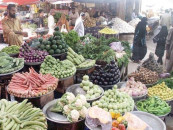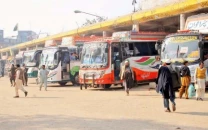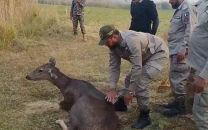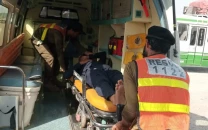Less than half of health budget used
Government concedes need to expand services delivery, address manpower shortfall

PHOTO: FILE
“There is a dire need to expand services delivery and address the shortfall in health related human resources and making better use of technology,” stated the Economic Survey for the fiscal year 2017-18 which was unveiled in the capital on Thursday.
The survey says that outgoing fiscal year saw the federal and provincial governments allocate Rs384.57 billion for the sector, amounting to around 1.12 per cent of the Gross Domestic Product (GDP) of the country. This was up from Rs273.34 allocated in FY 2016-17 and 31.75 per cent higher than the actual expenditures of Rs291.9 billion in the last fiscal year.
Not even 25% of health, education funds utilised: report
But until February, the government had utilised less than half of the allocated sum of around Rs167.16 billion, or just 43.5 per cent of the allocated budget. However, this was still better from the same period in the last fiscal year when the government had spent only Rs121.57 billion.
Despite the increased allocation, the funds were far short of the World Health Organisation (WHO) benchmark of allocating at least six per cent of the GDP for basic and lifesaving services.
Out of the total health spending, Punjab boasted the major chunk with 84.8 per cent of the funds spent, followed by Sindh with 41.4 per cent, Khyber-Pakhtukhawa (K-P) with 17.6 per cent, Balochistan with 11.3 per cent while the federal government spent only 12 per cent of the allocated amount.
The federal government and Balochistan were the only areas where development expenditures had doubled from the FY 2016-17. But Punjab, Sindh and K-P recorded greater increase in allocation for non-development expenditures during the same period.
Only half of education budget utilised thus far
Free Healthcare Services
The government allocated Rs15 billion in Public Sector Development Programme (PSDP) 2017-18 for the two phases of the Prime Minister’s National Health Programme.
As of January 31, 2018, more than 1.65 million families have enrolled in the programme and more than 56,000 families have been treated for various illnesses from 125 empanelled hospitals across Pakistan.
Polio almost eradicated
Through polio eradication efforts, a substantial investment has been made in strengthening health service delivery systems in Pakistan.
Thousands of health workers have been trained, hundreds of volunteers have been mobilised to support immunisation campaigns, and cold-chain transport equipment has been refurbished.
Consequently, polio incidence has nose-dived from 198 in 2011 to just eight in 2017 and only one case so far in 2018.
K-P struggles to spend budget in first half of fiscal year
Poor ratio
Investment in health over years have seen improvement in health facilities and health care providers.
By 2017, the number of public sector hospitals has increased to 1,211. On the other hand, the number of basic health units (BHUs) increased to 5,508, rural health centres (RHC) to 676 and dispensaries to 5,697.
The survey said that the overall population of registered doctors in the country had increased marginally from 195,896 in 2016 to 208,007 in 2017. This means that there was one doctor available for every 957 people in 2017, improving from a doctor for every 997 people in 2016.
This is still a far cry from the WHO recommended ratio of 4.4 doctors for 1,000 people.
It is poorer still for dentists who number only 20,463 in the country or a single dentist for 9,730 people. There are 103,777 nurses, while only one hospital bed is available for 1,580 people. Even though their numbers are increasing, the pace of it is too slow for a population which has grown to over 208 million.
The achievements of the health sector during 2016-17 included the establishment of 3,100 hospital beds against the target of 5,000 beds, 5,000 new doctors, 500 dentists, 3,200 Nurses, 4,500 paramedics, 450 midwives and 9,000 Lady Health Workers (LHWs).
Food expenditure
Food expenditure rose from Rs2,046 in July to Rs2,400 in October 2017 and gradually decreased to Rs2,085 in March 2018. The average cost remains at Rs2,250 per person per month from July 2017 to March 2018. The cost is calculated every month for the basic food basket, providing 2,100 calories and 60 grammes of protein, using data from Pakistan Bureau of Statistics.
Published in The Express Tribune, April 27th, 2018.



















COMMENTS
Comments are moderated and generally will be posted if they are on-topic and not abusive.
For more information, please see our Comments FAQ